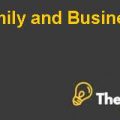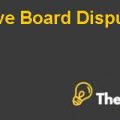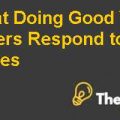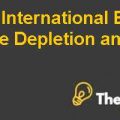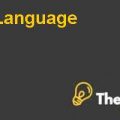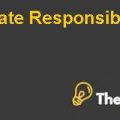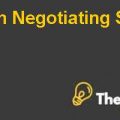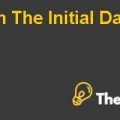
Valley Wide Utilities Company
Organizational Change and Development
Section One:
Company background
Valley wide is a privately owned utility company which is facing some financial crises due to its expansion facilities. The president of the company appointed two consultants named John Givens and Hilda Hirsh in order to provide the company with MBO performance standards along with the identification of key standards for controlling the performance. Specifically, the company wants to attain goals as they cannot be attained in isolation.
Since few years, the company is facing performance evaluation problems. Moreover, dissatisfaction is also emerging among employees. According to managers, the MBO standards of the company are very tough and the workers are threatening to leave the work. Company hired two consultant named John and Hilda, who do not have enough knowledge and experience to evaluate the performance on individual or team basis but they both have just improved their performance level on few items but have not gain specifically tried to improve the overall organizational performance.
It has been analyzed that the initial participation between the teams have been increased which resulted in increase in employee’s productivity. On the other hand, dissatisfaction is also rising as the management believes that standards built by consultants were either very tough or unfair and bias.
Dilgado, the president of the company have been pushing the problems and considering everything is fine. However, some engineers were threatening company that they will quit the company. Consequently, the president promised to reconsider and agreed to make changes in the MBO plan only if it would be appropriate and create strategic fit to the company’s policy.
Problem Statement
The major problem faced by the company is the dissatisfaction, which is being spread among employees. Moreover, the MBO standards were considered either difficult or biased. Consequently, the major employees such as engineers were threatening to leave the company, which would be very harmful to the company.
Discussion of the problems:
The problems mentioned above are very critical for the company as it results in the poor performance of the team members which may affect the performance on the individual basis as well as on the organizational level. Management by objectives (MBO) is a very crucial concept in deciding the goals for any organization because it determines the intensity of goals and the timing to achieve those goals through its limited resources and workforce (Jon, June 26, 2013).
This involves the participation of the employees in setting the goals collectively as a team for the fulfillment of individual as well as organization goals and performance is improved. But, the problem faced by the company is inexperienced leaders and managers for setting the goals which created the problems for the company.
Causes of problems:
The above problems have resulted into severe adverse conditions for the company. The problems have resulted due to the cause of the improper management style. They are using autocratic style of leadership who just set challenging goals which are unattainable and the timing for achieving those goals is even set as very short which creates problems for the employees and create a lot of disturbance for the employees (Iqbal, Anwar, & Haider, 2015).
They are unable to manage the work-life balance due to the job stress. Company has also not set its objectives for the motivation of employees rather the company has only tried to emphasize more on problematic side rather than encouraging positive side of the management. Causes of the dissatisfaction in employees were the unfair and biased goals set by the management and standards were not up to the mark which insisted the management to look after the situation and provides reasonable grounds for resolving the issues (Odine, 2015).
Other causes of the problems in employees’ performance were lack of communication and coordination among team members which created a huge disturbance to achieve the targeted goals and the performance standards. The managers were autocratic and were not supporting its employees in achieving those goals rather they were giving tough time to its employees by showing biasness in providing perks and benefits.
Company was not providing performance based pay to its employees which results in very much disappointment among its employees and their individual as well as organizational performance is very much affected. This also resulted due to the poor organizational structure which created problems for the organization in transmitting the information from top management to lower level employees and upward communication flow was also distorted which resulted in dissatisfaction for the employees.
Systems affected by the above-mentioned problems:
These problems created a very big problem for the company which resulted in the lack of coordination and communication between departments. The challenging goals created problems for the company’s procurement department and strategic planning department was unable to coordinate with the other departments.
Sales targets and projections were not up to the mark due to the challenging goals set by the standards which resulted in the lack of alignment of the Internal and external environment of the organization with the Strategy, Structure, Technology and Infrastructure of the company’s department. This resulted in the poor cultural norms in the organization and hence resulted in the lack of performance of the overall organization and employee’s dissatisfaction.
Lack of strategic fit between the organizational goals and the strategies to achieve those goals which resulted in the feeling of dissatisfaction and unbiased decisions of management due to the lack of expertise and experience for managing the teams. Employees were unable to share their ideas due to the lack of support from management which created disturbance and stress among employees (AlBattat & Som, 2013).
Moreover, this overall process resulted in the process of change management to bring about the positive results for the organization and change the behavior of the management to support its employees and the performance is maximized by motivating the employees through the below mentioned alternatives.
Discussion of alternatives:
The alternatives which can be suggested for overcoming the above mentioned major three problems which are related to the poor organizational structure, lack of setting MBO standards and Employees dissatisfaction due to the unfair and bias decisions of the management. These problems can be resolved by bringing change management in culture of the organization, setting SMART goals and providing a fair pay plan for the employees through encouraging the proper information flow (Robins, 2014).
To resolve the issues related to MBO, management is suggested to review its standards of MBO so that its performance may be evaluated and set according to the principle of SMART goals which can easily be measured, and attained on a provided time period which are realistic and are simple which can encourage and motivate its employees. This will improve the performance of organization as well as satisfaction level among employees by striving to attain challenging goals.
The poor structure of the organization can be improved by introducing a decentralized structure in which the authority and responsibility will be transferred along with the freedom of action. This will help the organization in making its downward, upward and horizontal communication flow as effective and efficient for the achievement of attainable goals through two-way communication and participation of employees (Conrad, 2014). The organization structure will be effective by the reporting power given to the departmental manager which will bring more effective results.
Poor culture was the result of poor HR policies and practices for retaining its employees which can be improved by setting the standards of performance based pay. If an employee performs well, he will be given good pay and good working conditions which attract the employees for better performance.
The organizational culture can be improved by welcoming the creativity and innovations among its employees for motivation which will result in better coordination and communication among departments. Company should enrich its culture by involving the employees in decision making and the management style should be democratic which results in the better goal setting through change management.
Recommendations:
The above alternatives can result in the better performance by following a strategic plan with proper implantation planning to overcome the barriers Valley Wide Utilities Company is facing. Company should prepare a proper planning to achieve the goals mentioned in the Standards by stating that the standards will result in personal and professional development and growth for individual as well as overall organization. The implementation plan for developing better MBO standards will be through involving the employees and management for setting the goals. This should be kept in mind that the goals set should be SMART which needs to be evaluated on a timely basis for the necessary alterations in the plan to achieve the optimum level performance.
MBO standards can be changed by implementing the strategic interventions by improving the planning through strategic actions and providing effective ways of improvement in communication. The tasks will be defined with the definite time period which can be easily achieved by the employees (Chen & Huang, 2009). The performance will be evaluated on weekly basis to amend the discrepancies and improve it further to utilize the company’s resources to the best possible level. Goals should be set in a way to improve the long term performance rather than short term performance.
Second recommendation which can be suggested from the above mentioned problem analysis and alternatives are to build the strong relationships with the employees by creating trust, belief and confidence. This will result in Human process interventions which involve the understanding of the needs and wants of each team member by diagnosing the problem in more detail which will eventually enhance the processes by changing the behaviors, decision making tactics, performance of the tasks, better interpersonal relationships and better negotiation skills by providing the Human relations interventions by providing training and development to the managers for gaining the experience for managing the teams. This should be evaluated by merging the employees in a team and guiding them to achieve the individual as well as team goals (Brown, 2011).
Furthermore, company is recommended to set its objectives in such a way that it becomes attainable along with maintaining some challenges for the motivation level to achieve the higher targets which needs high efforts and thus satisfaction will also be high. Company needs to bring techno structural interventions by changing the rigid autocratic organizational structure to a more democratic and participative approach where creative ideas are welcomed and are rewarded for the better performance. This may result in reducing the job ambiguity and roles will be clear to all the employees through the proper standards. Company can also keep its technology updated to change the culture of team and overall organization for improving the overall organizational performance.
Section two:
Change process:
Change process comes into practice when there are problems related to the behavior and structure of the organization. The employees and management often resist changing their behaviors and management styles which results in the conflicts and stressing among the team members and organizational different departments. Change management can be implemented by preparing proactively for the set objectives with proper measures of performance so that it can be evaluated on the basis of overcoming the problems with recommended alternatives.
The situational analysis for diagnosing the problem was the first stage to bring change by evaluating the organizational issues in detail which requires a certain set of actions for identifying the possible causes of the problems. The possible causes will be evaluated in detail for bringing the possible alternatives which will be sorted out for reaching at a recommended action plan by implementing the interventions and the methods for bringing change in the organization for improving its performance.
Change management can be a cyclical process by unfreezing the current situation and behavior of employees by movement which will lead to the refreezing of the behaviors so that they keep the change process intact and this may lead to the change management by carrying out the research for bring effective methods of change through strategic, techno-structure, human resource and human process interventions through proper implementation plan.
References
- AlBattat, S., & Som, P. (2013). Employee Dissatisfaction and Turnover Crises in the Malaysian Hospitality Industry. International Journal of Business and Management; Vol. 8, No. 5 .
- Brown, D. R. (2011). An Experimental Approach to Organizational Development. Prentice Hall. Eighth edition .
- Chen, C. J., & Huang, J. W. (2009). Strategic human resource practices and innovation performance — The mediating role of knowledge management capacity. Journal of Business Research 62 , 104-114.
- Conrad, D. (2014). Workplace Communication Problems: Inquiries by Employees and Applicable Solutions. Journal of Business Studies Quarterly, Volume 5, Number 4 .
- Issue Information. (2017). Global Business and Organizational Excellence, 36(3), pp.1-4
- Iqbal, N., Anwar, S., & Haider, N. (2015). Effect of Leadership Style on Employee Performance. Arabian Journal of Business and Management Review .
- Jon, D. (June 26, 2013). Does Management by Objectives (MBO) Still Work As an Approach Today? The Practice of Management .
- Robins, E. M. (2014). An Instructional Approach to Writing SMART Goals. TCC .
- Martin, J. (2002): Organizational behavior. [London]: Thomson Learning
- Odine, M. (2015). Communication Problems in Management. Journal of Emerging Issues in Economics, Finance and Banking (JEIEFB)-Volume4 .

